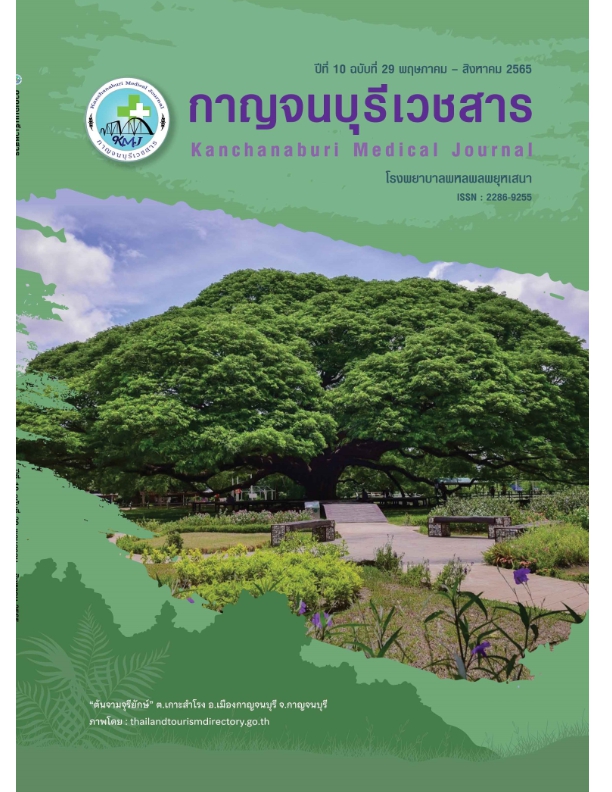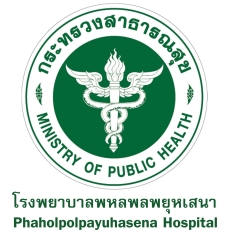อุบัติการณ์และปัจจัยที่มีผลต่อภาวะเลือดออกในกะโหลกศีรษะของผู้บาดเจ็บสมองไม่รุนแรงที่มารับบริการในห้องฉุกเฉิน โรงพยาบาลมะการักษ์
บทคัดย่อ
การบาดเจ็บสมองไม่รุนแรงเป็นปัญหาที่พบได้บ่อยในห้องฉุกเฉิน ซึ่งการส่งตรวจเอกซเรย์คอมพิวเตอร์สมองเป็นวิธีการที่ดีที่ใช้ในการวินิจฉัยภาวะเลือดออกในกะโหลกศีรษะ แต่ยังมีข้อขัดแย้งในการส่งตรวจเอกซเรย์คอมพิวเตอร์สมอง เนื่องจากมีผู้บาดเจ็บจำนวนน้อยที่มีภาวะเลือดออกในกะโหลกศีรษะในขณะที่ค่าใช้จ่ายสูงและผู้ป่วยได้รับรังสีโดยไม่จำงานวิจัยนี้มีวัตถุประสงค์เพื่อศึกษาอุบัติการณ์และปัจจัยที่มีผลต่อภาวะเลือดออกในกะโหลกศีรษะของผู้บาดเจ็บสมองไม่รุนแรงที่มารับบริการในห้องฉุกเฉิน โรงพยาบาลมะการักษ์ วิธีการดำเนินวิจัยเป็นการศึกษาแบบย้อนหลังโดยเก็บข้อมูลจากเวชระเบียน ในผู้บาดเจ็บสมองไม่รุนแรง (ระดับการรับรู้สติกลาสโกว์ 13-15) ที่อายุ 15 ปีขึ้นไปและได้รับการส่งทำเอกซเรย์คอมพิวเตอร์สมอง ระหว่าง 1 ตุลาคม พ.ศ. 2563 ถึง 30 มิถุนายน พ.ศ. 2565
ผลการศึกษาผู้บาดเจ็บสมองไม่รุนแรง 211 ราย พบว่า ผู้บาดเจ็บ 57 ราย (ร้อยละ 27) มีเลือดออกในกะโหลกศีรษะ และพบปัจจัยที่มีผลต่อความผิดปกติอย่างมีนัยสำคัญทางสถิติ คือการมีระดับการรับรู้สติกลาสโกว์ 13 (RR=8.941, 95%CI; 1.75-45.7, p=0.006) และอาการที่บ่งบอกว่าได้รับการบาดเจ็บที่ฐานกะโหลกศีรษะ(RR=3.902, 95%CI; 1.76-8.66, p=0.001)อุบัติการณ์การเกิดเลือดออกในกะโหลกศีรษะของผู้บาดเจ็บสมองไม่รุนแรงที่มารับบริการในห้องฉุกเฉิน โรงพยาบาลมะการักษ์ คิดเป็นร้อยละ 27 โดยพบว่าการมีระดับการรับรู้สติกลาสโกว์ 13 และอาการที่บ่งบอกว่าได้รับการบาดเจ็บที่ฐานกะโหลกศีรษะ เป็นปัจจัยเสี่ยงที่มีผลต่อภาวะเลือดออกในกะโหลกศีรษะอย่างมีนัยสำคัญทางสถิติ
เอกสารอ้างอิง
ราชวิทยาลัยศัลยแพทย์แห่งประเทศไทย,วิทยาลัยประสาทศัลยแพทย์แห่งประเทศไทย, กรมการแพทย์กระทรวงสาธารณสุข, สถาบันประสาทวิทยา กรมการแพทย์กระทรวงสาธารณสุข. แนวทางการรักษาการบาดเจ็บที่ศีรษะ (Clinical Practice Guideline for Head Injury), 2561.
Mathers CD, Loncar D.Projections of global mortality and burden of disease from 2002 to 2030. PLoS Med. 2006 Nov;3(11):e442.
Silverberg N, Duhaime AC, Laccario M. Mild Traumatic Brain Injury in 2019-2020. JAMA. 2020;323(2):177-178.
Limsuriyakan W, Lorwanich P. Factor associated with intracranial hemorrhage in mild traumatic brain injury moderated risk patients at Phra Nakhon Si Ayutthaya Hospital. TUH journal. 2019 Sep;4(3).
Kamsuk S, Pearkao C. The prevalence and factors Related to intracranial hemorrhage in the mild traumatic brain injuries of patients admitted to the emergency room of Maharat Nakhon Ratchasima hospital. NIGRC 2016.
Yuksen C, Sittichanbuncha Y, Patumanond J, Muengtaweepongsa S, Aramvanitch K, Supamas A, et al. Clinical Factors Predictive for Intracranial Hemorrhage in Mild Head Injury. Hindawi. 2017;20.
Turcato G, Zaboli A, Zannoni M, Ricci G, Zorzi E, Ciccariello L, et al. Risk factors associated with intracranial bleeding and neurosurgery in patients with mild traumatic brain injury who are receiving direct oral anticoagulants. Am J Emerg Med. 2021 May;43:180-185.
Vaniyapong T, Patumanond J, Ratanalert S, Limpastan K. Clinical indicators for traumatic intracranial findings in mild traumatic brain injury patients. Surg Neurol Int. 2019;10(64).
Moustafa F, Roubin J, Pereira B, Barres A, Saint-Denis J, Perrier C, et al. Predictive factors of intracranial bleeding in head trauma patients receiving antiplatelet therapy admitted to an emergency department. Scand J Trauma Resusc Emerg Med. 2018 Jun;26(1):50.
Yamada C, Hagiwara S, Ohbuchi H, Kasuya H. Risk of Intracranial Hemorrhage and Short-Term Outcome in Patients with Minor Head Injury. World Neurosurg. 2020 Sep;141:e851-e857.
Sharif-Alhoseini M, Khodadadi H, Chardoli M, Rahimi-Movaghar V. Indications for brain computed tomography scan after minor head injury. J Emerg Trauma Shock. 2011 Oct-Dec; 4(4): 472–476.
Teeratakulpisarn P, Angkasith P, Wannakul T, Tanmit P, Prasertcharoensuk S, Thanapaisal C. What are the strongest indicators of intracerebral hemorrhage in mild traumatic brain injury?. Trauma Surg Acute Care Open. 2021 Aug 4;6(1):e000717.
Singata C, Candy S. Is computed tomography of the head justified in patients with minor head trauma presenting with Glasgow Coma Scale 15/15?. SA J Radiol. 2018 Sep 27;22(1):1329.
Molaei-Langroudi R, Alizadeh A, Kazemnejad-Leili E, Monsef-Kasmaie V, Moshirian S. Evaluation of Clinical Criteria for Performing Brain CT-Scan in Patients with Mild Traumatic Brain Injury; A New Diagnostic Probe. Bull Emerg Trauma. 2019 Jul;7(3):269-277.
Mishra Rk, Munivenkatappa A, PrathyushavC, Shukla DP, Devi BI. Clinical predictors of abnormal head computed tomography scan in patients who are conscious after head injury. J Neurosci Rural Pract. Jan-Mar 2017;8(1):64-67.
ดาวน์โหลด
เผยแพร่แล้ว
รูปแบบการอ้างอิง
ฉบับ
ประเภทบทความ
สัญญาอนุญาต
ลิขสิทธิ์ (c) 2022 โรงพยาบาลพหลพลพยุหเสนา

อนุญาตภายใต้เงื่อนไข Creative Commons Attribution-NonCommercial-NoDerivatives 4.0 International License.
บทความที่ได้รับการตีพิมพ์เป็นลิขสิทธิ์ของโรงพยาบาลพหลพลพยุหเสนา
ข้อความที่ปรากฏในบทความแต่ละเรื่องในวารสารวิชาการเล่มนี้เป็นความคิดเห็นส่วนตัวของผู้เขียนแต่ละท่านไม่เกี่ยวข้องกับโรงพยาบาลพหลพลพยุหเสนาและบุคลากรท่านอื่น ๆ ในโรงพยาบาลฯ แต่อย่างใด ความรับผิดชอบองค์ประกอบทั้งหมดของบทความแต่ละเรื่องเป็นของผู้เขียนแต่ละท่าน หากมีความผิดพลาดใด ๆ ผู้เขียนแต่ละท่านจะรับผิดชอบบทความของตนเอง





